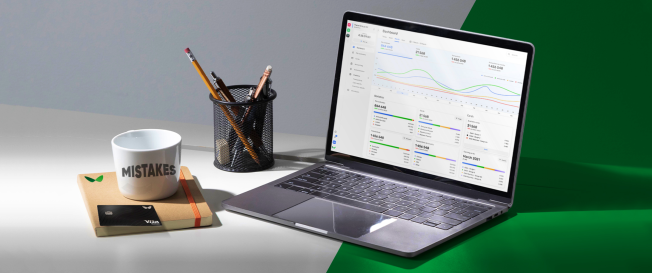Keeping track of business spending is a routine task that is very simple; however, every month, the finance staff waste essential time (and sleep) attempting to close the books.
As we shall see, the significant issues are common to businesses everywhere but are simple.
However, it might be challenging to think that there are better methods of doing business because businesses have always worked in a specific way.
When you think about it, it’s instantly clear how tough reconciliation is, so we will shed some light on it in this article. The good news is that the answers are equally as straightforward.
What is finance reconciliation?
Part of the financial reconciliation is checking and confirming that both records match. The objective is to identify any errors, fraud, or misconduct and to ensure that your documents are correct and that the expenses and income recorded match those in your books.
The most basic and obvious case is checking your closing bank balance against your income and cash flow figures to see if they balance out.
Typically, the end of the month is when the reconciliation of payments takes place. The well-known end-of-year financial closure procedure, which may be laborious and time-consuming, is another annual challenge for finance staff. The following sections will analyse various crucial methods for enhancing monthly and yearly close.
What is a reconciliation of expenses?
This similar method of record checks is used in cost reconciliation to verify that a company’s general ledger entries for spending line up with what the company actually spent. Financial controllers and accountants compare cost claims, transaction histories, and other core records with receipts, invoices, and other supporting documentation.
Knowing that your accounts are adequately managed in a one-person business is comparatively simple. You are the sole buyer and are thus fully aware of all expenditures and revenue.
However, ensuring that everything is legal in a larger organisation is more crucial because employees act as the business buyers.
Companies may verify that every payment was authorised, verified, and accompanied by a receipt through the reconciliation process. Otherwise, tracking where the company’s money is going is difficult.
Why expense reconciliation is difficult
Payment reconciliation is frequently a laborious and unappreciated chore, even though it should be commonplace.
The task itself is not the problem. We’ll see that different stages of the procedure cause the issues.
Here are a few of the primary headache triggers during closing time.
Disconnected sources of data
The most obvious problem is that information often comes from several sources. These may consist of the following:
- Orders or requests made by team members
- Statements for credit cards
- Loose invoices or other evidence of purchase
- Whether paid or unpaid invoices
- Managers’ written (or even verbal) approvals
It is your responsibility to confirm that the data on each corresponds and that the transactions are what they should be.
However, every single one of these data sources was made individually. It makes no difference to your credit card account how your purchase orders are formatted or whether a manager approved the payment.
Financial controllers spend a significant amount of effort just manually matching transactions unnecessarily. It may be easy, but it may be tedious and time-consuming.
Integrated delays
The fact that different data sources operate on various timeframes is another peculiarity of doing so. You receive your credit card statements representing the previous month a few days into the new month, though they might be a month or more late.
Assuming there are no problems with the statement, you can only close the books for the month concerned in the following month.
Budgeting is another factor. Let us assume that several people on your team are frequently travelling. They’re relatively conscientious and know what they do when submitting receipts and invoices. Submitting costs takes a few hours on the final Friday of the month.
Thus, you receive many cost reports and receipts on the final day of each month. It takes longer to close the books when someone eventually makes a mistake, and the pain worsens.
Poorly formatted data
As mentioned previously, the data you’re using wasn’t built to be merged. Your workers need to consider if their expense claim is formatted the same as a purchase order or if it looks exactly like their neighbour’s.
Do you receive a monthly credit card statement in the mail? That information must be manually entered.
Or perhaps it comes as a PDF if you use more up-to-date Internet banking. Can you quickly copy and paste from a PDF?
It takes much work to enter data from a credit card statement or expenditure report into your accounting software or spreadsheets. Ensuring they share the same ledger codes and expenditure accounts is another tale.
Faster methods for reconciling expenses
Automation, digitalisation, and decentralisation are three essential enhancements that ease the burden of many unpleasant financial activities. These concepts have many words, but they’re relatively straightforward.
✅ Automation
You have probably already automated some of your accounting processes. Examples of this are tools like current accounting automation software and “smart” spreadsheets that can replicate data between fields.
However, further automation may be the solution if the reconciliation procedure is complicated.
Document verification against transaction records is a task ripe for automation. Computers can quickly and efficiently sift through large amounts of data without getting frustrated or bored.
Even while this task is vital to the growth and profitability of the business, you won’t be able to provide much in the way of value. Instead of focusing on mundane tasks, let the program perform the work while you focus on more pressing issues.
However, there is something you’ll need if you wish to automate this procedure more thoroughly:
✅ Digitisation
We can’t build a paper empire. You will always have a lengthy procedure if you have to physically locate expense claims or receipts, enter their information manually, and then file them away. Because of this, any opportunity to switch to a digital workflow should be seized.
Just a few instances:
- Most tax authorities now accept e-receipts without question. Workers can snap a photo of the receipt using their smartphones to verify a purchase or submit an expense report.
- With digital invoicing, you no longer need to physically handle paper invoices before processing them via your accounting software. Instead, you can download PDF versions of them from your suppliers’ websites and proceed with the approval and transfer processes electronically. We can skip the waiting game with the post office.
- Apps may also be used to submit expenditure reports for employees. They won’t have to fill out an Excel document, have their boss sign it, and then send it in. They can do everything online; it’s ready to be reconciled after their manager approves it.
As a bonus, the rest of the organisation can relieve part of your burden thanks to digitalisation. If coworkers pitch in just a little, finance will only have to take on some of the data entry work.
“Decentralisation” describes this type of structure, in which teams are given more responsibility without giving up command.
✅ Decentralisation
In an ideal world, monetary considerations wouldn’t factor into every deal. Companies would have faith in their workers if they had a straightforward, repeatable method to train everyone to follow.
Although the world is imperfect, those, as mentioned earlier, can be accomplished now. Much of the expenditure process may be “decentralised,” allowing budget managers to execute their duties and make resources available to other employees.
In actuality, this implies:
- Employees should have constant access to payment mechanisms (expense claims or corporate cards) with safeguards to avoid fraud or misuse.
- Anyone can adhere to budgetary guidelines, irrespective of their knowledge or background in finance or legislation.
- Whether employees are on vacation or in a different time zone, remote-friendly solutions ensure that work continues uninterrupted.
- You may view your accounts anytime, anywhere, in real-time to ensure everything is running well.
The primary objective is to develop procedures that may be run asynchronously from any location. That’s invaluable under all conditions, especially when lockdowns are possible.
Automated, digital, and decentralised expenses
Expense reconciliation is a laborious task, which is why you’re here reading this post. Just telling someone to “get with the times” and update isn’t enough; you need to be shown the way.
Okay, but how can we put these ideas into practice?
1. Obtain more reliable means of payment.
2. Coordinate your spending procedures and rules.
3. Go with paperless invoicing and payments.
4. Automate as much of the accounting reconciliation as possible.
So, let’s take things in order and deal with them individually.
Innovative means of payment
You must first modernise those outdated payment options. Traditional credit cards, with their terrible statements, are just no longer acceptable, as we have witnessed. Along with their cousins, Excel or Word documents, paper expense claims have also been discontinued.
Most of the problems you have at month’s end are because these procedures weren’t created for businesses. They represent potential fixes.
We may use some newer, more convenient mobile-first banks for personal transactions. Your phone serves as a virtual ATM, allowing you to instantly add funds, view your account balance, and even alter your PIN.
There should be something similar for corporations. (Hint: there is.)
Integrated expenditure management
We have firsthand experience with the problems that arise when there are several data sources and a need for more financial literacy among staff. You can quickly get through both of these problems simultaneously.
The same software should handle invoices, credit card purchases (both online and in stores), and expense reports. In this approach, the accounting department can easily access all the required data while the staff always uses a system with which they are familiar.
Capturing documents digitally
Numerous articles have outlined the benefits of going digital. The repercussions of this for employees are as follows:
1. A smartphone app lets you take pictures of receipts.
2. An application for desktop use that allows customers to submit PDF invoices and electronic receipts
The instantaneous sharing of receipts through the mobile app ensures that none are misplaced or destroyed. In addition, finance teams may verify the accuracy of information shared by team members by checking these papers more frequently.
The most significant advantage is that financial teams no longer need to enter this information manually. One way to cut down on administrative work is to use a system that can automatically match a receipt with the appropriate purchase.
Reconciling automatically
You can reach the Holy Grail through these first three methods: Having your month-end procedures entirely automated. In particular, you may use software that records all financial dealings, verifies their legitimacy (by suspending payment pending permission), and cross-references the relevant paperwork with the transaction itself.
To put it simply, this is what reconciliation entails.
Even better, it will let you know which team members have forgotten something or made a mistake, so they can fix it without you having to do anything.
You will be responsible for rapidly reviewing the document to catch any glaring errors in this function. This will allow you to go on to the next phase of your contribution to the company, which is to distribute reports and offer suggestions.
Spending wisely makes expense reconciliation simple.
Financial reconciliation frequently concludes a lengthier chain. Problems at the end of the day are sometimes incorrectly attributed to this final procedure.
In reality, the weakest link in the chain is located much further upstream, where the issues first manifest, because reconciling is an easy process to implement. You are essentially just verifying that financial dealings are what they claim to be. However, challenges and complications arise when data needs to be corrected, papers are missing (often receipts), or tools are incompatible.
We advocate for a unified approach to expense management because of this. You need expense reimbursement and card payment systems to scan receipts, double-check amounts, and export data directly to your accounting software.
In reality, it’s much easier than the current mess of tools, cards, and paper you use.
Let’s meet to discuss your business case and how we can assist.
Don’t hesitate to reach out to us through this contact form.
Our team is always happy to help you in any way we can.


